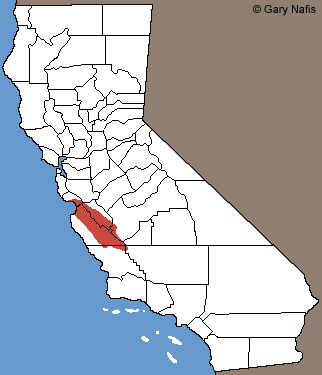 Red:
Red: Range in California
|
 |
| Adult, Monterey County |
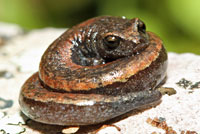 |
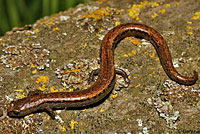 |
 |
| Juvenile, San Benito County |
Adult, Monterey County |
Adult, eastern Monterey County |
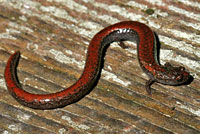 |
 |
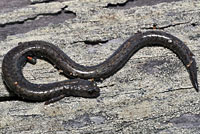 |
| Adult, eastern Monterey County |
Adult, Monterey Bay sand dunes, northern Monterey County |
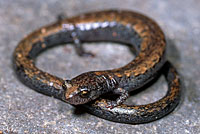 |
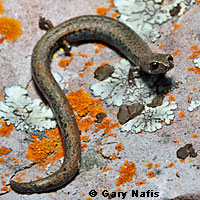 |
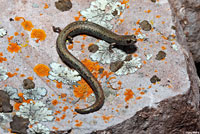 |
| Adult, northern Monterey County |
Adult, San Benito County |
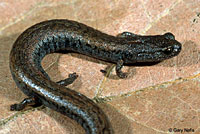 |
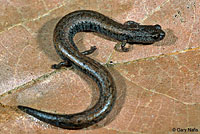 |
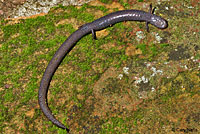 |
| Adult, San Benito County |
Underside of adult Adult, eastern Monterey County |
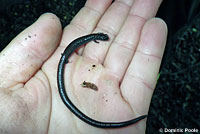 |
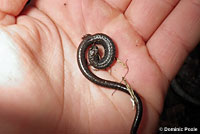 |
 |
These salamanders fouind in Stockton, San Joaquin County, were thought to be
B. attenuatus, but genetic testing showed them to be an introduced population of
B. gavilanensis. © Dominic Poole |
Slender Salamanders (genus Batrachoseps) have only 4 toes on their hind feet. All other California salamanders have 5 toes on their hind feet. |
| |
|
|
| Comparisons with some similar sympatric species. |
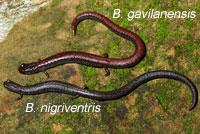 |
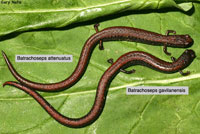 |
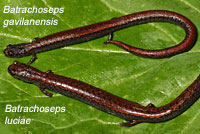 |
Top: B. gavilanensis
Bottom: B. nigriventris -
Black-bellied Slender Salamander
The ranges of these species overlap in some areas. |
Left: B. attenuatus - California Slender Salamander
Right: B. gavilanensis
In Southern Santa Cruz County, the ranges of these species overlap. They are very similar, but you can see here that B. gavilanensis has proportionally larger fingers and toes. |
Top: B. gavilanensis
Bottom: B. luciae - Santa Lucia Mountains Slender Salamander
The ranges of both salamanders meet in one region. They are nearly identical in appearance. At one time they were considered to be the same species,
B. pacificus. |
| |
|
|
| Habitat |
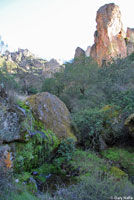 |
 |
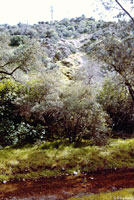 |
| Habitat, San Benito County |
Habitat, San Benito County |
Habitat, Gabilan Mountains,
San Benito County
|
 |
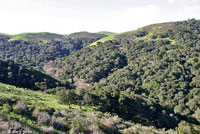 |
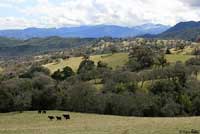 |
| Monterey bay coastal sand dunes habitat, Monterey County |
Habitat, Monterey County |
Habitat, San Benito County |
| |
|
|
| Short Video |
| |
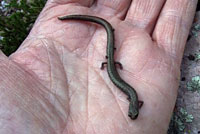 |
|
| |
Several Gabilan Mountains Slender Salamanders are seen on a cold late winter day along with some of their habitat. |
|
| |
|
|
| Description |
| |
| Size |
Adults are 1 1/2 to 2 3/5 inches long (3.8 - 6.6 cm) from snout to vent, or 3 3/4 to 6 1/2 inches (9.5 - 16.5 cm) in total length.
|
| Appearance |
A small thin salamander with 19-22 costal grooves.
Short limbs, a narrow head, long slender body, very long tail, and conspicuous costal and caudal grooves give this species the worm-like appearance typical of most Slender Salamanders.
There are four toes on the front and hind feet, which is typical of all Slender Salamanders. (Other California salamanders have five toes on the hind feet.) |
| Color and Pattern |
Gray with brownish black ground color and there may be a distinct brownish gray to coppery tan dorsal stripe extending onto the tail and bordered by blackish dots.
Small whitish speckling mark the sides.
|
| Comparison with Sympatric Slender Salamanders |
Coexists with B. nigriventris in the southern part of its range. B. gavilanensis is the larger, more robust, of the two species, with longer limbs and a broader neck and head than B. nigriventris.
|
| Life History and Behavior |
A member of family Plethodontidae, the Plethodontid or Lungless Salamanders.
Plethodontid salamanders do not breathe through lungs. They conduct respiration through their skin and the tissues lining their mouth. This requires them to live in damp environments on land and to move about on the ground only during times of high humidity. (Plethodontid salamanders native to California do not inhabit streams or bodies of water but they are capable of surviving for a short time if they fall into water.)
Plethodontid salamanders are also distinguished by their nasolabial grooves, which are vertical slits between the nostrils and upper lip that are lined with glands associated with chemoreception.
All Plethodontid Salamanders native to California lay eggs in moist places on land.
The young develop in the egg and hatch directly into a tiny terrestrial salamander with the same body form as an adult.
(They do not hatch in the water and begin their lives as tiny swimming larvae breathing through gills like some other types of salamanders.)
|
| Activity |
Active on rainy or wet nights when temperatures are moderate, late fall through spring, mostly December to April.
Retreats underground when the soil dries or when air temperature drops to near freezing.
|
| Defense |
Slender salamanders use several defense tactics, including:
- Coiling and remaining still, relying on cryptic coloring to avoid detection.
- Uncoiling quickly and springing away repeatedly bouncing over the ground, then remaining still again to avoid detection.
- Detaching the tail, which wriggles on the ground to distract a predator from the salamander long enough for it to escape.
(After its tail is detached or severed, the salamander will grow a new tail.) |
| Diet and Feeding |
Eats a variety of small invertebrates.
A sit-and-wait predator, using a projectile tongue to catch prey. |
| Reproduction |
Reproduction is terrestrial.
|
| Eggs |
| Egg deposition sites are unknown. It is assumed that females lay eggs in moist places underground as with other species of Batrachoseps. |
| Young |
Young develop completely in the egg and hatch fully formed.
|
| Habitat |
Habitats include moist redwood forests, gray pine and mixed evergreen forests, oak woodlands, chaparral, and open grasslands with scattered oaks. Habitat at the southern end of the range tends to be hot and semi-arid, and populations are localized in moist areas on north-facing slopes. Typically found under rocks, logs, bark, driftwood, and other surface debris.
|
| Geographical Range |
Endemic to California. Occurs along the central coast of California from the base of the Santa Cruz mountains at Rodeo Gulch, Santa Cruz County, southward to the eastern margin of the city of Monterey, at Jack's Peak. Occurs inland into the Gabilan and Diablo mountains and the east slope of the Santa Lucia mountains south into northern San Luis Obispo county, and the Temblor Range in Kern County (where salamanders are tentatively assigned to this species.)
Co-exists with B. attenuatus, in Santa Cruz County (Hecker Pass is one location), and B. nigriventris in the southern part of its range (Mustang Ridge and Peachtree Valley). May coexist with B. luciae in Carmel Valley and near Arroyo Seco.
A population of slender salamanders found in Stockton has been genetically identified as B. gavilanensis most similar to salamanders from near Santa Cruz. (Jockusch et al, 2020)
|
| Elevational Range |
From sea level to around 5,000 ft. (1,500 m).
|
| Notes on Taxonomy |
B. gavilanensis was described in 2001. Salamanders now known as B. gavilanensis were formerly recognized as Batrachoseps pacificus which has been split into ten different species due to molecular studies.
Here's a Diagram of the Batrachoseps Complex showing the relationships between species.
Alternate and Previous Names (Synonyms)
Batrachoseps gavilanensis - Gabilan Mountains Slender Salamander (Jockusch, Yanev, Wake 2001, Stebbins 2003)
Batrachoseps pacificus relictus - Relictual Slender Salamander (Stebbins 1985)
Batrachoseps attenuatus - California Slender Salamander (Stebbins 1954, 1966)
Batrachoseps attenuatus attenuatus - Worm-salamander (Bishop 1943)
Batrachoseps attenuatus - Slender Salamander (Storer 1925)
Batrachoseps nigriventris (Cope 1869)
Batrachoseps attenuatus (Cooper 1868)
Batrachoseps attenuata (Baird 1850)
Salamandrina attenuata (Eschscholtz 1833)
|
| Conservation Issues (Conservation Status) |
| No known critical conservation concerns. Common and widespread throughout their range, some of which is relatively undisturbed publicly owned lands. |
|
| Taxonomy |
| Family |
Plethodontidae |
Lungless Salamanders |
Gray, 1850 |
| Genus |
Batrachoseps |
Slender Salamanders |
Bonaparte, 1841 |
Species
|
gavilanensis |
Gabilan Mountains Slender Salamander |
Jockusch, Yanev & Wake, 2001 |
|
Original Description |
Elizabeth L. Jockusch, Kay P. Yanev, and David B. Wake ''Molecular phylogenetic analysis
of slender salamanders, genus Batrachoseps (Amphibia: Plethodontidae), from central coastal
California with descriptions of four new species.'' Herpetological Monographs, #15 2001.
|
|
Meaning of the Scientific Name |
Batrachoseps - Greek - batrachos = amphibian, frog + seps = lizard — describes lizard-like appearance
gavilanensis - of the Gabilan Mountains (type locality.)
from Scientific and Common Names of the Reptiles and Amphibians of North America - Explained © Ellin Beltz
|
|
Similar Neighboring Salamanders |
Batrachoseps attenuatus
Batrachoseps luciae
Batrachoseps nigriventris
Batrachoseps minor
Batrachoseps incognitus
|
|
More Information and References |
California Department of Fish and Wildlife
AmphibiaWeb
Elizabeth L. Jockusch, Kay P. Yanev, and David B. Wake ''Molecular phylogenetic analysis of slender salamanders, genus Batrachoseps (Amphibia: Plethodontidae), from central coastal California with descriptions of four new species.'' Herpetological Monographs, #15 2001.
Hansen, Robert W. and Shedd, Jackson D. California Amphibians and Reptiles. (Princeton Field Guides.) Princeton University Press, 2025.
Stebbins, Robert C., and McGinnis, Samuel M. Field Guide to Amphibians and Reptiles of California: Revised Edition (California Natural History Guides) University of California Press, 2012.
Stebbins, Robert C. California Amphibians and Reptiles. The University of California Press, 1972.
Flaxington, William C. Amphibians and Reptiles of California: Field Observations, Distribution, and Natural History. Fieldnotes Press, Anaheim, California, 2021.
Nicholson, K. E. (ed.). 2025. Scientific and Standard English Names of Amphibians and Reptiles of North America North of Mexico, with Comments Regarding Confidence in Our Understanding. Ninth Edition. Society for the Study of Amphibians and Reptiles. [SSAR] 87pp.
Samuel M. McGinnis and Robert C. Stebbins. Peterson Field Guide to Western Reptiles & Amphibians. 4th Edition. Houghton Mifflin Harcourt Publishing Company, 2018.
Stebbins, Robert C. A Field Guide to Western Reptiles and Amphibians. 3rd Edition. Houghton Mifflin Company, 2003.
Behler, John L., and F. Wayne King. The Audubon Society Field Guide to North American Reptiles and Amphibians. Alfred A. Knopf, 1992.
Robert Powell, Roger Conant, and Joseph T. Collins. Peterson Field Guide to Reptiles and Amphibians of Eastern and Central North America. Fourth Edition. Houghton Mifflin Harcourt, 2016.
Powell, Robert., Joseph T. Collins, and Errol D. Hooper Jr. A Key to Amphibians and Reptiles of the Continental United States and Canada. The University Press of Kansas, 1998.
American Museum of Natural History - Amphibian Species of the World 6.2
Bartlett, R. D. & Patricia P. Bartlett. Guide and Reference to the Amphibians of Western North America (North of Mexico) and Hawaii. University Press of Florida, 2009.
Bishop, Sherman C. Handbook of Salamanders. Cornell University Press, 1943.
Lannoo, Michael (Editor). Amphibian Declines: The Conservation Status of United States Species. University of California Press, June 2005.
Petranka, James W. Salamanders of the United States and Canada. Smithsonian Institution, 1998.
Jockusch EL, Hansen RW, Fisher RN, Wake DB. 2020. Slender salamanders (genus Batrachoseps) reveal Southern California to be a center for the diversification, persistence, and introduction of salamander lineages. PeerJ 8:e9599 https://doi.org/10.7717/peerj.9599
|
|
|
The following conservation status listings for this animal are taken from the April 2024 State of California Special Animals List and the April 2024 Federally Listed Endangered and Threatened Animals of California list (unless indicated otherwise below.) Both lists are produced by multiple agencies every year, and sometimes more than once per year, so the conservation status listing information found below might not be from the most recent lists. To make sure you are seeing the most recent listings, go to this California Department of Fish and Wildlife web page where you can search for and download both lists:
https://www.wildlife.ca.gov/Data/CNDDB/Plants-and-Animals.
A detailed explanation of the meaning of the status listing symbols can be found at the beginning of the two lists. For quick reference, I have included them on my Special Status Information page.
If no status is listed here, the animal is not included on either list. This most likely indicates that there are no serious conservation concerns for the animal. To find out more about an animal's status you can also go to the NatureServe and IUCN websites to check their rankings.
Check the current California Department of Fish and Wildlife sport fishing regulations to find out if this animal can be legally pursued and handled or collected with possession of a current fishing license. You can also look at the summary of the sport fishing regulations as they apply only to reptiles and amphibians that has been made for this website.
This salamander is not included on the Special Animals List, meaning there are no significant conservation concerns for it in California according to the California Department of Fish and Wildlife.
|
| Organization |
Status Listing |
Notes |
| NatureServe Global Ranking |
|
|
| NatureServe State Ranking |
|
|
| U.S. Endangered Species Act (ESA) |
None |
|
| California Endangered Species Act (CESA) |
None |
|
| California Department of Fish and Wildlife |
None |
|
| Bureau of Land Management |
None |
|
| USDA Forest Service |
None |
|
| IUCN |
|
|
|
|
|




























